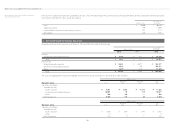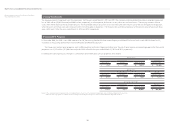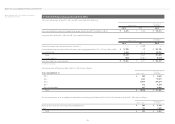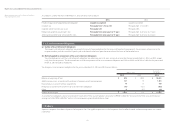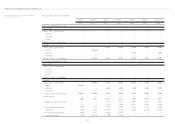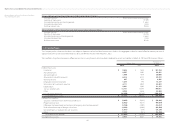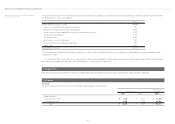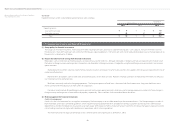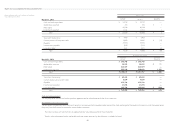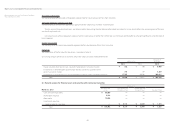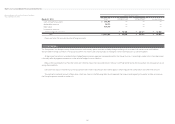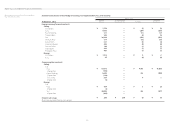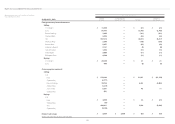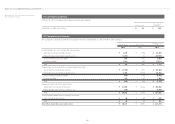Brother International 2013 Annual Report Download - page 47
Download and view the complete annual report
Please find page 47 of the 2013 Brother International annual report below. You can navigate through the pages in the report by either clicking on the pages listed below, or by using the keyword search tool below to find specific information within the annual report.
46
(As lessor)
Expected revenues under noncancellable operating leases were as follows:
Millions of Yen
Thousands of
U.S. Dollars
2013 2012 2013
Operating leases:
Due within one year ¥8 ¥8 $85
Due after one year 42 30 447
Total ¥50 ¥38 $ 532
17. Financial Instruments and Related Disclosures
(1) Group policy for financial instruments
The Group uses financial instruments, mainly long-term debt including bank loans, based on its capital financing plan. Cash surpluses, if any, are invested in low risk
financial assets. Short-term bank loans are used to fund the Group’s ongoing operations. Derivatives are used, not for speculative purposes, but to manage exposure to
financial risks as described in (2) below.
(2) Nature and extent of risks arising from financial instruments
Receivables, such as trade notes and trade accounts, are exposed to customer credit risk. Although receivables in foreign currencies are exposed to the market risk of
fluctuation in foreign currency exchange rates, the position, net of payables in foreign currencies, is hedged by using forward foreign currency contracts and currency
option contracts.
Marketable and investment securities, mainly held-to-maturity securities and equity instruments of customers and suppliers of the Group, are exposed to the risk of
market price fluctuations.
Payment terms of payables, such as trade notes and trade accounts, are less than one year. Payables in foreign currencies are exposed to the market risk of fluctua-
tion in foreign currency exchange rates.
Bank loans are mainly used to fund ongoing operations. The long-term portion of bank loans is borrowed with fixed interest rates. Long-term bank loans were
mainly used to fund the acquisition of shares of Nissei Corporation.
Derivatives mainly include forward foreign currency contracts and currency option contracts, which are used to manage exposure to market risks from changes in
foreign currency exchange rates of receivables and payables, respectively. Please see Note 18 for more detail about derivatives.
(3) Risk management for financial instruments
Credit risk management
Credit risk is the risk of economic loss arising from counterparty’s failure to repay or service debt according to the contractual terms. The Group manages its credit risk
from receivables on the basis of internal guidelines, which include monitoring of payment terms and balances of major customers by each business administration
department to identify the default risk of customers at an early stage. With respect to held-to-maturity financial investments, the Group manages its exposure to credit
risk by limiting investment to high credit rated bonds in accordance with its internal guidelines.
The maximum credit risk exposure of financial assets is limited to their carrying amounts as of March 31, 2013.
Notes to Consolidated Financial Statements
Brother Industries, Ltd. and Consolidated Subsidiaries
Year ended March 31, 2013


